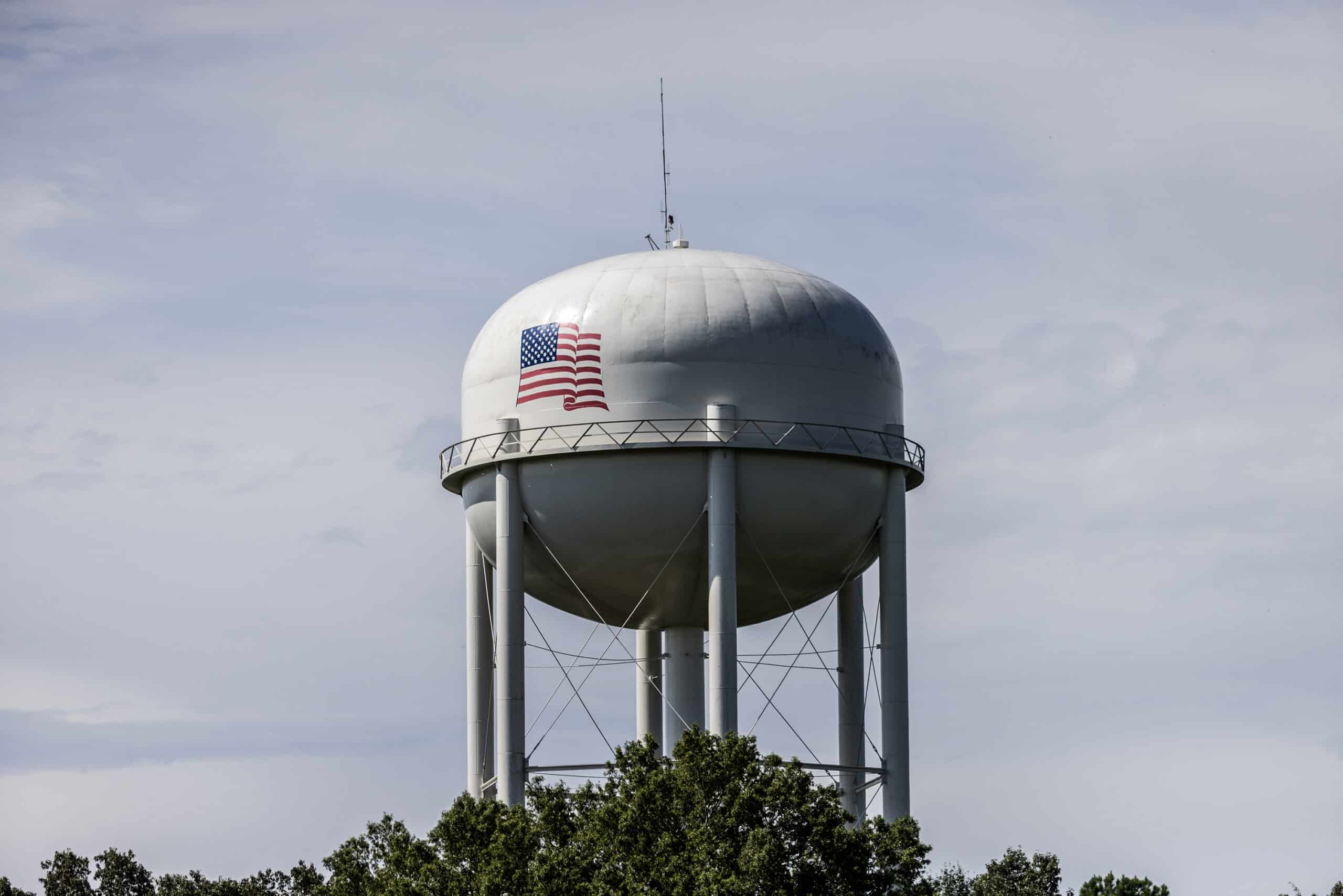Mississippi Today
‘Forever chemicals’ in drinking water are worrying Mississippi residents

If Alabama's experience foreshadows Mississippi's future, expect the EPA to find plenty of toxic “forever chemicals” in the drinking water.
A 2022 map shows Alabama with plenty of drinking water exceeding the recommended limit for these chemicals, known as per- and polyfluoroalkyl substances or PFAS. They have been linked to cancer, birth defects, kidney disease, liver problems, decreased immunity, and increased risk of asthma and thyroid issues.
Mississippians remain in the dark about these forever chemicals, however, because the state doesn't test.
Anna Reade, senior scientist at the National Resource Defense Council, said testing is critical to keeping drinking water safe. “We can't assume we don't have exposure to PFAS unless we test,” she said. “Maine found high levels of PFAS in wells that had gone untested for two decades.”
Once hailed for producing items that could resist heat, stains or water, these chemicals are now considered a menace around the globe. Five nations have already agreed to a European ban on PFAS.
Such a ban would cover the thousands of different types of PFAS, which can be found in everything from non-stick cookware to dental floss. The most closely studied PFAS are perfluorooctanoic acid — PFOA — and perfluorooctanesulfonate — PFOS.
Rather than ban all PFAS, the EPA initially put health advisories on those two chemicals at 70 parts per trillion in drinking water, which have since been updated to well under 1 ppt for PFOA and for PFOS. EPA's newly proposed regulation would limit them to 4 ppt each.
EPA Administrator Michael S. Regan is pushing to reduce current limits because of health problems associated with these chemicals. He said such a change would “prevent thousands of deaths and reduce tens of thousands of serious PFAS-related illnesses.”
A 2020 study suggests up to 200 million Americans are drinking forever chemicals beyond 1 part per trillion — a level that some experts have proposed as a safe limit for drinking water.
Les Herrington, director of Environmental Health for the state Department of Health, discounted the health risks to Mississippians. He pointed to EPA testing in 2013 and 2014, which “all produced results below detection limits and did not indicate potential concerns at that time.”
Recent testing by Consumer Reports, in collaboration with Mississippi Spotlight, however, raises questions about what might have happened since.
Consumer Reports tested 149 drinking municipal and well water samples in Mississippi's 82 counties. Of those, 146 contained measurable levels of PFAS. Nearly a third of them exceeded EPA's health advisory for PFOA in drinking water, and almost half exceeded the health advisory for PFOS.
Crystal Dotson, 39, of Corinth and her family saw their drinking water tested at 92.5 ppt in total PFAS, which is far beyond the level of 10 that Consumer Reports recommends. (The EPA has no recommendation on total PFAS, just PFOA and for PFOS.)
She wonders if the forever chemicals have played a role in the declining health of her family since they moved to the city of Corinth a decade ago.
Her 56-year-old husband, Tim, who was in good health, has now developed high blood pressure and polycystic kidney disease. Both hypertension and kidney disease have been linked to these forever chemicals.
Before moving to Corinth, he took blood pressure medicine. Now he's allergic to that medicine and similar medication.
Their 17-year-old daughter, Stella, is now suffering from two auto-immune diseases, psoriasis and psoriatic arthritis. A series of studies have found exposure to PFAS interfere with immune function.
Their 13-year-old daughter, Veda, had to visit a cardiologist because her heart rate and blood pressure were spiking. “They're running all kinds of tests,” Dotson said.
She said she believes forever chemicals are playing a role in the decline of her family's health. “You really feel helpless. Our kids are starting out life sick.”
In 2013, the city of Corinth began to get its drinking water from the Tennessee River via the Tenn-Tom Waterway.
Experts say PFAS can be found at oil refineries, water treatment plants, airports, military sites and a number of industrial sites. From there, the PFAS migrate into streams, landfills or other places before winding up in the soil and drinking water.
Tim believes his family, which also gets their drinking water from the Tennessee River, has been affected. “My brother-in-law has two types of cancer,” he said. “My sister has brain cancer. Everybody in my family has had cancer.”
Many states aren't waiting for the EPA to act. Bills attacking the PFAS problem have been introduced in 35 states, including Georgia, Florida and Texas, according to Safer States. At least half have taken steps to regulate PFAS in drinking water or expand their monitoring. Mississippi isn't one of them.
As for Dotson, she isn't waiting. She plans to talk with the city of Corinth about these PFAS.
Since learning what was in their tap water, the Dotsons have started drinking from store-bought bottles, costing them about $15 a week.
Consumer Reports has identified four water filters, including two pitchers and two under-sink models, that can help consumers filter out forever chemicals.
Some systems, such as reverse osmosis, can cost thousands, which is more than many Mississippians can afford. Even if they can, they might not be able to install such a system, because a third of Mississippians, like the Dotsons, rent their homes.
Crystal hopes the family can convince their landlord to install a reverse osmosis system, she said. “We worry about our children. We want to help them.”
Kelly Hunter Foster, senior attorney for the Waterkeeper Alliance, an environmental advocacy organization, said a more ideal solution would be for states to prohibit the release of PFAS, “rather than try to filter them out on the back end. The public should not have to pay for the pollution that these companies create.”
Mississippi is one of at least 18 states that have sued PFAS manufacturers and distributors, saying they knew “these compounds were toxic” and sold them anyway. The lawsuit, filed in federal court, demands that they pay “to investigate, assess, remediate, monitor, and restore the sites in Mississippi” where PFAS were used. Minnesota settled with one manufacturer, 3M, for $850 million.
Mississippi's lawsuit identifies these known sites as contaminated: Gulfport Combat Readiness Training Center, Gulfport Naval Construction Battalion Center, Keesler Air Force Base, Columbus Air Force Base, Key Field Air National Guard Base, Jackson Air National Guard Base and Naval Air Station Meridian.
Military bases typically use firefighting foam, which has historically contained PFAs. These forever chemicals can be found in many other places, including fast-food packaging. In a 2022 study, Consumer Reports found PFAS in packaging from every retailer tested.
“Additional investigation and testing will undoubtedly uncover further contamination across the State,” the lawsuit says.
In January 2022, Emmy Morrison and her husband bought their downtown Hattiesburg home.
They found water filters on the faucets because of the lead. She was stunned to find out the bigger problem was PFAS.
Thousands of these forever chemicals exist, but regulators test for only a handful of them.
“Unless you are controlling and testing for all those different types of PFAS, you're missing major amounts of risk,” said Foster of the Waterkeeper Alliance. “When we look at samples we see some of the highest levels in the rare lesser types of PFAS.”
A decade ago, EPA officials tested for six forever chemicals in 80 of Mississippi's drinking water systems. This year, they are testing for 29 chemicals in 239 water systems and will release the results here.
Consumer Reports tested for 43 chemicals. That is far short of the thousands of PFAS that exist.
Rather than attack PFAS as a class, the regulatory system in America “is stuck on a toxic treadmill,” said Reade of the National Resource Defense Council. “The EPA has taken a small step in the right direction to get off that treadmill.”
In contrast, the European Union is moving toward phasing out all PFAS, she said. “They're attacking PFAS at their source. Here, we're still approving new PFAS.”
The National Resource Defense Council is pushing to reduce “people's exposure to PFAS,” she said. “We can't make it zero, but we can definitely reduce their exposure and, therefore, their risk. We need to stop adding to the problem in the first place.”
In Morrison's home, Consumer Reports found a total of 43.6 PFAS, which is four times more than Consumer Reports' recommendation of 10.
That concerns the 62-year-old Morrison. “I'm glad I'm not young,” she said.
At least 2,000 people have filed litigation against DuPont, alleging that pollution from the plant has harmed their health, and juries have awarded millions in damages.
In 2005, the EPA uncovered evidence that DuPont had concealed the toxic effects of PFOA, and the company paid a $10.25 million fine, which the agency at the time called the largest environmental administrative penalty in its history.
In 1981, DuPont spotted PFOA in blood samples from pregnant workers in its plant in Washington, West Virginia, and at least one woman had transferred the chemical to her baby, according to the settlement. A decade later, the company learned that the forever chemical was in the public water supply.
DuPont said nothing, and in 2001, the EPA learned of the problem from an attorney working on class-action litigation on behalf of citizens in Ohio and West Virginia who had been affected by the chemical, according to the settlement.
As for House, testing showed total PFAS in her drinking water to be 20.7.
“We've got junk in the water,” she said. “I can't say I'm surprised.”
Before the 74-year-old moved back to her hometown eight years ago, she had a reverse osmosis system for her drinking water in Tampa. Now back on the Mississippi Gulf Coast, she has no such system.
These days, she uses a refrigerator filter on the tap water she drinks. Now she wonders what she needs to do to be safe. “Do I need to bring Perrier from France?” she asked.
She is researching the matter, she said. “I didn't come this far in life to want to come down with liver cancer.”
This investigation was conducted by Consumer Reports in partnership with Mississippi Spotlight, a collaboration between Mississippi Today, the Clarion Ledger and Mississippi Public Broadcasting.
This article first appeared on Mississippi Today and is republished here under a Creative Commons license.
Mississippi Today
On this day in 1951


April 28, 1951

Ruby Hurley opened the first permanent office of the NAACP in the South.
Her introduction to civil rights activism began when she helped organize Marian Anderson's 1939 concert at the Lincoln Memorial. Four years later, she became national youth secretary for the NAACP. In 1951, she opened the organization's office in Birmingham to grow memberships in Alabama, Florida, Georgia, Mississippi and Tennessee.
When she arrived in Mississippi, there were only 800 NAACP members. After the governor made remarks she disagreed with, she wrote a letter to the editor that was published in a Mississippi newspaper. After that step in courage, membership grew to 4,000.
“They were surprised and glad to find someone to challenge the governor,” she told the Chicago Defender. “No Negro had ever challenged the governor before.”
She helped Medgar Evers investigate the 1955 murder of Emmett Till and other violence against Black Americans. Despite threats, she pushed on.
“When you're in the middle of these situations, there's no room for fear,” she said. “If you have fear in your heart or mind, you can't do a good job.”
After an all-white jury acquitted Till's killers, she appeared on the front cover of Jet magazine with the headline, “Most Militant Negro Woman in the South.”
Months later, she helped Autherine Lucy become the first Black student at the University of Alabama.
For her work, she received many threats, including a bombing attempt on her home. She opened an NAACP office in Atlanta, where she served as a mentor for civil rights leader Vernon Jordan, with whom she worked extensively and who went on to serve as an adviser to President Bill Clinton.
After learning of Evers' assassination in 1963, she became overwhelmed with sorrow. “I cried for three hours,” she said. “I shall always remember that pool of blood in which he lay and that spattered blood over the car where he tried to drag himself into the house.”
She died two years after retiring from the NAACP in 1978, and the U.S. Post Office recognized her work in the Civil Rights Pioneers stamp series. In 2022, she was portrayed in the ABC miniseries, “Women of the Movement.”
This article first appeared on Mississippi Today and is republished here under a Creative Commons license.
Mississippi Today
Rare open negotiations occur on important Medicaid expansion issue
The curtain was pulled back last week for the first time in years on the Mississippi Legislature's often mysterious conferencing process.
A conference committee consists of three representatives and three senators appointed to try to reach agreement when the two chambers pass differing versions of the same bill. Last week, a conference committee formed to try to reach agreement on Medicaid expansion caused a stir by meeting in a public setting.
Even though the joint rules of the Mississippi Legislature call for an open conferencing process, the conferees seldom meet in public. They usually meet and negotiate their differences near the end of the session behind closed doors.
That was not always the case.
For a period in the late 1990s and early 2000s, the Legislature, under intense pressure from the Mississippi Press Association, made open conference committees the norm.
Some major issues have been played out in public conference committees. Notable open conferences include:
- The infamous, excruciatingly long special session in 2002 where businesses received more protection from lawsuits.
- Budget fights when Haley Barbour was governor when legislators often would reach an impasse in the negotiations process and spend the bulk of their time talking about their cars and eating candy.
- The major rewrite of the state's economic development package under then-Gov. Ronnie Musgrove called Advantage Mississippi.
- The Mississippi Adequate Education Program, which for decades has provided the state's share for the basic operation of local school districts. It was hammered out in an open conference process in 1997 even before the joint rules mandated the open process.
Then-state Sen. Musgrove and former House Speaker Billy McCoy deserve credit or blame, according to one's perspective, for proving the open conference process could work. When they chaired their respective chamber's education committees, they insisted on having an open conference process.
But in more recent years, open conference committees have been few and far between. The joint rule has been largely ignored.
The fact that the three House and three Senate conferees agreed to meet at least once in public on Medicaid expansion — one of the most pivotal issues facing the Legislature in recent years — drew considerable attention.
If nothing else, the open conference committee provided a raw and unedited view of how far apart the two chambers were at the time on an issue that would provide additional health care coverage to primarily the working poor.
The House wanted to provide coverage to those earning up to 138% of the federal poverty level, or about $20,000 annually for an individual, while the Senate had proposed providing coverage to those earning less than 100% of the federal poverty level, or about $15,000 per year.
According to various experts, the House plan would provide coverage to many more working Mississippians and cost less to the state than would the Senate plan. The reason for the lower cost to the state is that when expanding to 138%, the federal government will pay 90% of the costs and provide the state an additional roughly $700 million over two years as an enticement to expand.
Under the Senate plan, the federal government will pay 77% of the cost and offer no incentives. It is important to understand that in the expensive world of health care, the difference in 77% of the cost and 90% means tens of millions to Mississippi state coffers.
The House conferees repeatedly pointed out those numbers — their plan covering more at less cost — during last week's open conference committee.
One of the reasons legislators through the years have not been enamored with an open conference process is that it has often turned into efforts by the negotiators to sell their position to the public.
Once the open conference process starts, the side that feels the most comfortable with its position wants to meet more often in full view of the public to make sure the public understands where each side stands.
For whatever it is worth, the House conferees were more enthusiastic about continuing the open process after the initial Medicaid expansion conference committee.
And after that initial open conference, the Senate offered a compromise to cover those earning up to 138% of the federal poverty level — just as the House proposed.
This article first appeared on Mississippi Today and is republished here under a Creative Commons license.
Mississippi Today
Legislation to strip key power of PERS Board passes both chambers
Legislation that strips significant power from the board that governs the state's public employee pension program has passed both chambers of the Legislature.
Under the legislation set to go to Gov. Tate Reeves during the final days of the 2024 session, the Public Employees Retirement System Board would no longer have the authority to increase the contribution rate levied on governments (both on the state and local level) to help pay for the massive retirement system.
The legislation, which passed both chambers in recent days, was a reaction to the decision by the board to increase by 5% over a three-year period the amount local governments contribute to each employee's paycheck for their retirement. Under the PERS Board plan, the employer contribution rate would have been increased to 22.4% over three years, starting with a 2% increase on July 1.
The board said the increase was needed to ensure the long-term financial stability of the system that pays retirement benefits for most public employees on the state and local levels, including staff of local school districts and universities and community colleges.
City and county government officials in particular argued that the 5% increase would force them to cut government services and lay off employees.
Under the bill passed by the Legislature there still would be a 2.5% increase over five years — a .5% increase in the employer contribution rate each year for five years.
In addition, legislative leaders said they plan to put another $100 million or more in state tax dollars into the retirement system in the coming days during the appropriations process.
Under current law, the PERS Board can act unilaterally to increase the amount of money governmental entities must contribute to the system. But under the new bill that passed both chambers, the board can only make a recommendation to the Legislature on increasing the employer contribution rate.
The PERS Board also would be required to include an analysis by its actuary and independent actuaries on the reason the increase was needed and the impact the increase would have on governmental entities.
In the 52-member Senate, 14 Democrats voted against the bill. Only one House member voted against the proposal.
Sen. David Blount, D-Jackson, said the bill failed to address the financial issues facing the system. He said a permanent funding stream is needed.
Blount said, “You are moving in the wrong direction and weakening the system” with the bill the Legislature approved. “Is it painful? Is it going to cost more money? Yes, but we need to do it” to fix the system.
The system has assets of about $32 billion, but debt of about $25 billion. But Sen. Daniel Sparks, R-Belmont, and others argued that the debt was “a snapshot” that could be reduced by strong performance from the stock market. The system depends on its investments and contributions from employers and employees as sources of revenue.
The system has about 360,000 members including current public employees and former employees and retirees.
The legislation states that no changes would be made for current members of the system. The legislation does reference looking at possibly changing the system for new employees. But that would be debated in future legislative sessions.
The bill does not include an earlier House proposal to dissolve the PERS Board, which consists primarily of people elected by the members of the system, and replace them with political appointees.
This article first appeared on Mississippi Today and is republished here under a Creative Commons license.
-
Local News3 days ago
Sister of Mississippi man who died after police pulled him from car rejects lawsuit settlement
-
Mississippi Today3 days ago
At Lake High School in Scott County, the Un-Team will never be forgotten
-
Mississippi News7 days ago
Forest landowners can apply for federal emergency loans
-
Mississippi News1 day ago
One injured in Mississippi officer-involved shooting after chase
-
Mississippi News6 days ago
Cicadas expected to takeover north Mississippi counties soon
-
Mississippi News5 days ago
Viewers make allegations against Hatley teacher, school district releases statement – Home – WCBI TV
-
Mississippi News7 days ago
Nationwide health alert issued for ground beef over potential E. coli risk
-
Mississippi News Video4 days ago
Vehicle struck and killed man lying in the road, Alcorn County sheriff says






































